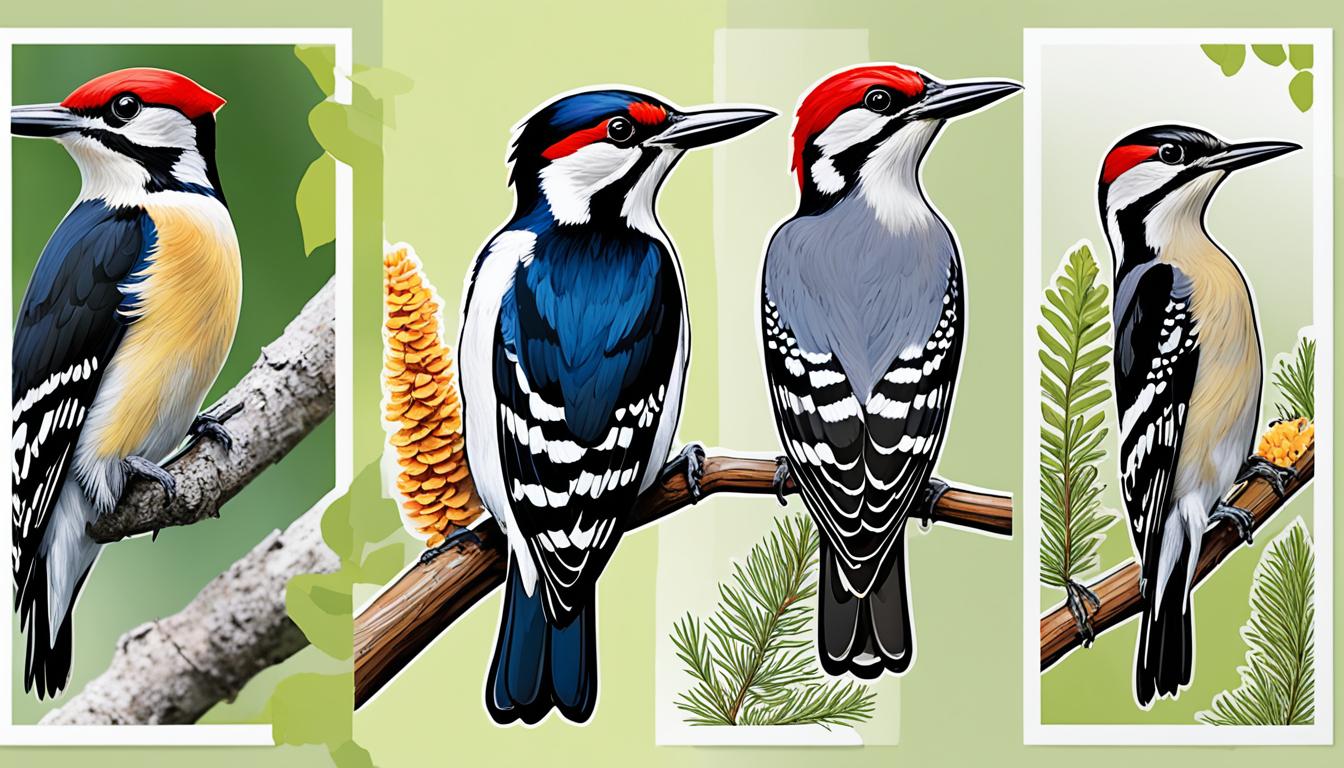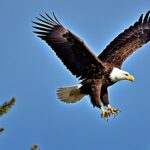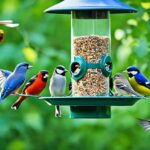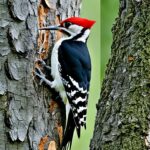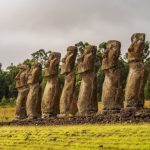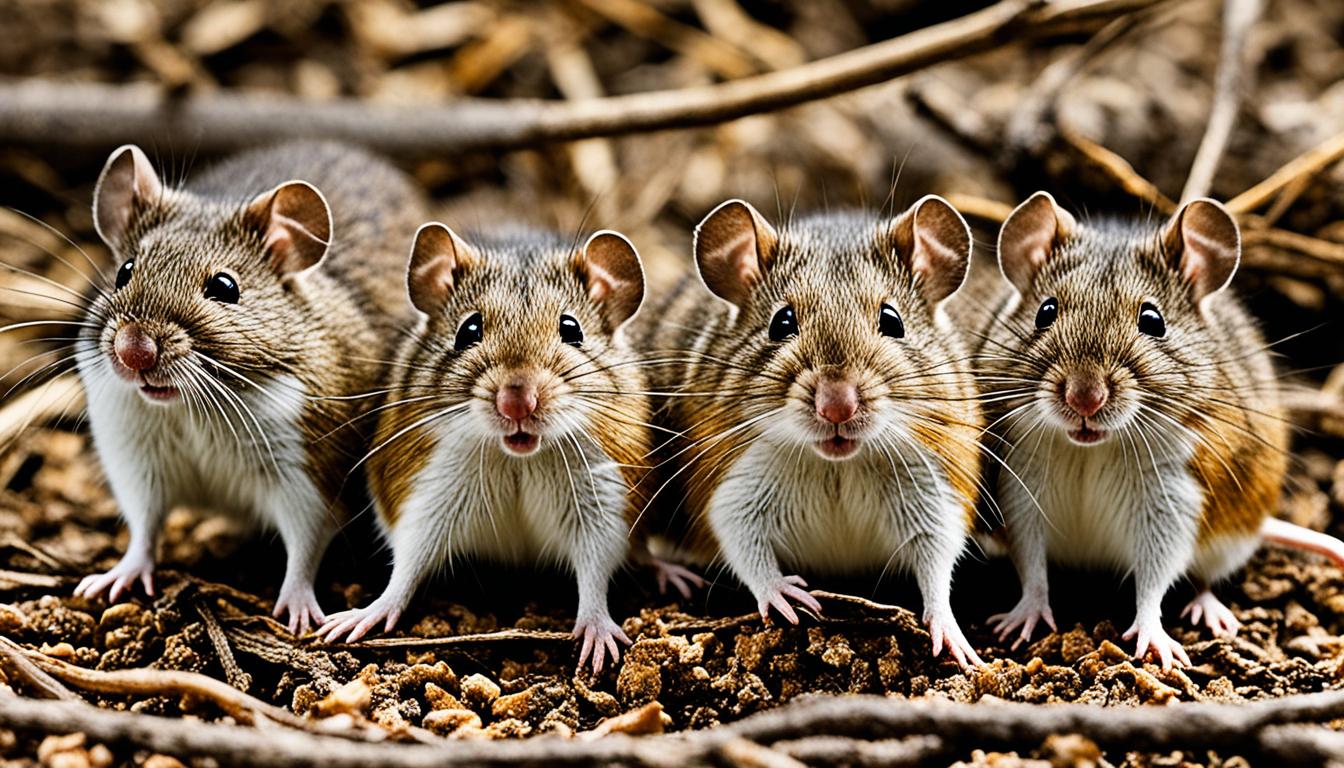There are 23 native woodpecker species in the USA. Identifying them, though, can be simple or tricky. The most common ones are easy to find. But, they face threats like losing their homes and pesticides. This has made some, like the Ivory-billed Woodpecker, almost disappear. Groups such as the American Bird Conservancy are working hard to save them by protecting where they live and spreading the word.
To tell one woodpecker from another, a good guide is key. American woodpeckers come in many kinds, and each has its own look and behavior. To recognize them, look at their feathers, listen to their calls, and see how they eat.
Understanding Woodpecker Behavior and Habits
Woodpeckers are truly unique creatures, making them very interesting to watch. They behave in amazing ways, from their drumming so loud you can hear it far, to how they eat. To know which woodpecker is which in the US, you must first understand how they act.
Typical Woodpecker Feeding Habits
Woodpeckers eat in ways that make them stand out. They use their sharp bills to dig into trees, looking for insects. Others, such as the Acorn Woodpecker, save their food in special trees by placing acorns in holes. This shows how adaptable and unique woodpeckers are.
Nesting and Territorial Behaviors
Woodpeckers find different places to build nests, depending on their type. For example, the Gila Woodpecker picks Saguaros in deserts to live in. Most woodpeckers, though, make their homes in holes they drill in trees, using their strong beaks. They also mark their own special areas with loud sounds, showing who they are and what’s theirs.
To know woodpeckers well, you should see how they hunt, where they make homes, and how they protect their space. This helps in correctly spotting the various woodpecker types found in the US.
Key Morphological Features of Woodpeckers
When trying to identify US woodpeckers, looking at their body features is very useful. Woodpeckers have special parts that help them live and work well in nature. Their strong, chisel-like bills are very noticeable. These bills are great at drilling into wood. It helps woodpeckers search for bugs and make homes.
Woodpeckers also have hard tail feathers. These help them stay steady against tree trunks. This steadiness is key when they are pecking the wood. It gives them the exactness needed. They also have special toes. Two toes point forward and two backwards. These feet make it easy for woodpeckers to hold onto trees and walls.
For finding US woodpeckers accurately, look at their colors, sizes, and bills. These differences are very important. They help tell one woodpecker type from another in the USA. Take the Northern Flicker and the Downy Woodpecker. They look very different, which makes it easier to know which bird you see.
Knowing about these special woodpecker parts is not just for spotting them. It also teaches us about the amazing ways they are built. By learning these details, birdwatchers can have a better time and learn more about woodpeckers.
Common Species of Woodpeckers in the USA
The United States is home to many woodpecker species, each with its special traits. Notably, the Acorn, Hairy, and Ivory-billed Woodpeckers bring uniqueness to the scene. They live in different areas and are known for what makes them stand out.
Acorn Woodpecker
Acorn Woodpeckers live in western forests with lots of oak trees. They are famous for their creation called granary trees. These are used for storing food, showing their smart and social ways. You could call them the masters of storing food together.
Hairy Woodpecker
Hairy Woodpeckers adapt well in both eastern and western forests. They use their strong beaks to find food other birds can’t. This shows their role in keeping the forests healthy by controlling insect populations.
Ivory-billed Woodpecker
The Ivory-billed Woodpecker was once a big part of the east’s forests but is now near extinction. Loss of their natural homes and hunting hit them hard. Saving the places they live and not hunting them is crucial to keep them around.
Identifying Woodpeckers by Their Calls
Learning woodpecker calls is key for bird lovers and researchers. Each kind of woodpecker has its own sounds. They use these sounds to claim their area or find a partner. Knowing their calls helps spot them, especially when you can’t see them well.
The Pileated Woodpecker stands out with its loud and far-reaching call. It uses this to mark out where it lives and talk to others of its kind. In contrast, the Northern Flicker makes a laugh-like sound that’s unique among woodpeckers.
If you listen to woodpecker calls, you can learn a lot about how they act and talk. Using apps to record and study these calls can teach you more. This is extra good to do during the time of year they’re making more sounds.
Getting to know the sounds of different birds can make birdwatching more fun and informative. It turns a walk in the forest into an educational journey. When you get good at recognizing woodpeckers by their calls, you help both science and nature by tracking different species accurately.
Woodpecker Identification by Region
Spotting different woodpecker types adds to the thrill of Birdwatching USA. Each area has its own special kind of woodpecker. They have found ways to live in specific places.
Western United States
In the Western US, places like the desert and pine-oak forests are home to woodpeckers. The Gila and Arizona Woodpeckers are well-suited to these regions. They find everything they need in these areas.
Eastern United States
Woodpeckers like the Red-bellied and Pileated ones live in Eastern US forests. They prefer living in places with many trees. This region is perfect for seeing and hearing these colorful birds.
Southern United States
The Southern US is where the rare Red-cockaded Woodpecker lives. It loves Longleaf Pine forests. Helping with their protection and watching them is a great way to enjoy Birdwatching USA.
How do you identify different types of woodpeckers in the USA?
Spotting different types of woodpeckers in the USA is not easy. But, there are a few tricks. Look at the bird’s size, shape, patterns, and colors. Getting good at noticing these details helps a lot in telling woodpeckers apart.
Using Size and Shape
Size and shape really help in telling woodpecker species apart. Take the Downy Woodpecker. It’s small, only about 6 inches long. On the other hand, the Pileated Woodpecker is huge, reaching up to 19 inches. Shape matters too. The Pileated Woodpecker has a long neck and a pointed top to its head. This is much different from the chubby body and short beak of the Downy Woodpecker.
Distinguishing Patterns and Colors
Looking at the colors and patterns on a woodpecker is key. For instance, the Red-bellied Woodpecker stands out with its red top and sides of the head. But its belly is mostly white. The Ladder-backed Woodpecker, however, has a unique black-and-white back. Both are easy to spot when you know what to look for.
Woodpecker Species of Conservation Concern
The endangered woodpeckers like the Ivory-billed, Red-cockaded, and Lewis’s Woodpecker are in trouble. They are facing big drops in their populations. The main threats they face are losing their homes, changes in where they live, and a lack of good fires. It is critical to act now to help these bird species thrive again.
Detailed Guide to the Acorn Woodpecker
The Acorn Woodpecker is a captivating bird with unique behaviors and habits. It stands out for its use of granary trees to store thousands of acorns. These trees are important community spots that the woodpeckers defend. This highlights their tight social structure.
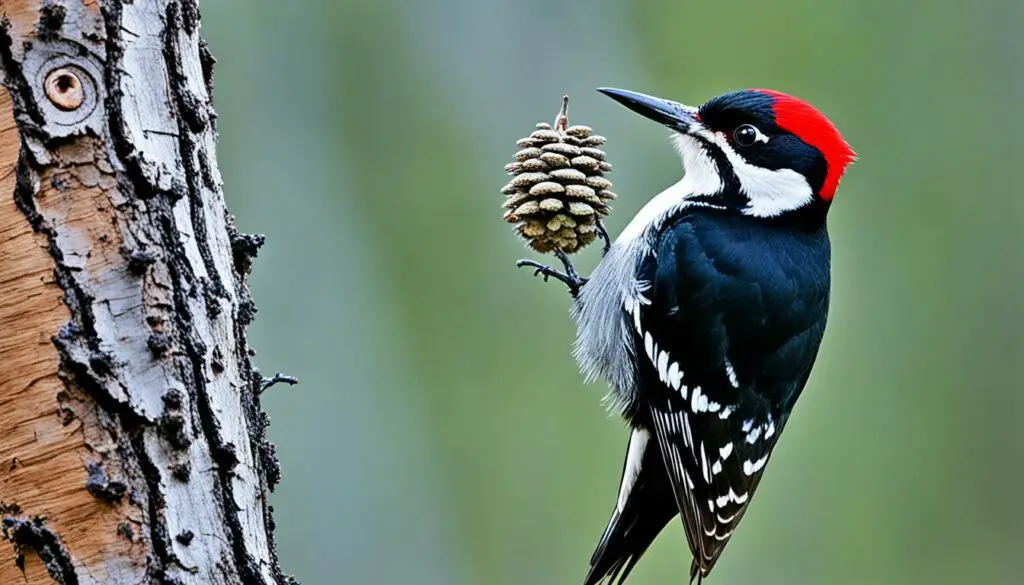
This bird loves western forests, where there are many oak trees. Oaks are vital for their acorn storage system. You can spot an Acorn Woodpecker by its black and white feather pattern and red crown, making it easy to find in the wild.
If you’re into birdwatching, here are some birdwatching tips:
- Observe their unique storage behavior: Search for granary trees. You might see these birds hiding acorns in the bark.
- Listen for their calls: Pay attention to their special sounds. They can give away their location, even if you can’t see them.
- Focus on social interactions: Acorn Woodpeckers like being around others. Watching them is very interesting and tells us a lot about how they live together.
Let’s look at some important facts about the Acorn Woodpecker:
| Feature | Description |
|---|---|
| Habitat | Western forests with oaks |
| Diet | Acorns, insects, fruit |
| Behavior | Stores acorns in granary trees, highly social |
| Identification | Black and white plumage, red crown |
| Call | Distinctive vocalizations |
With more people watching, studying Acorn Woodpecker habits is very fulfilling. Keep these birdwatching hints in mind for your next nature outing. You’ll see just how fascinating these woodpeckers are.
Detailed Guide to the Red-bellied Woodpecker
The Red-bellied Woodpecker is easily noticed because of its bright red nape and striped back. This makes it a key species in any Woodpecker identification guide. Despite the name, its belly is pale, not red.
You can find this woodpecker in many places across the eastern United States. It thrives in forests, suburbs, and even parks. This shows how versatile and adaptable this bird is.
Its drumming and sounds are distinct, different from other birds. The Red-bellied Woodpecker is doing well in the changing environment. Its numbers are rising, which is good news.
| Feature | Details |
|---|---|
| Appearance | Bright red nape, striped back, pale belly |
| Habitat | Eastern US forests, suburban areas, parks |
| Behavior | Distinct drumming, vocalizations |
| Population Trend | Increasing |
Once you know the unique markings and sounds, spotting these birds is easy. Learning about the Red-bellied Woodpecker is great for bird species info. It also makes birdwatching more enjoyable.
Woodpecker Habitats and Their Preferences
Woodpeckers live in many places, showing they can adapt well. They are found in deep forests, dry deserts, and busy cities. This shows how tough and successful they are in evolving to their different homes.
Forested Areas
In forests, woodpeckers are key for the ecosystem. They eat insects and make homes in trees, helping other animals that use their old homes. Forests provide a lot of food and places to nest, perfect for woodpeckers.
Desert Scrub
Woodpeckers like the Gila and Gilded Flickers live in dry, desert scrub areas. They have special ways to live in these tough places. For example, they find food and nest in cacti, showing their clever survival skills.
Urban Environments
More and more, woodpeckers are living in cities. Birds like the Downy Woodpecker are doing well in parks and suburban areas. Their success in cities shows they are very adaptable, even near people.
The table below shows where woodpeckers like to live and how they adapt:
| Habitat Type | Common Species | Key Adaptations |
|---|---|---|
| Forested Areas | Northern Flicker, Pileated Woodpecker | Insect predation, cavity nesting |
| Desert Scrub | Gila Woodpecker, Gilded Flicker | Nesting in cacti, water conservation |
| Urban Environments | Downy Woodpecker, Red-bellied Woodpecker | Use of urban trees for nesting, exploiting bird feeders |
Woodpecker Identification Tips for Birdwatchers
Learning about woodpeckers can make birdwatching fun and rewarding. First, get to know their physical features. Look at their bill shapes, colors, and any special marks on their bodies.
It’s also key to watch how woodpeckers act. For instance, some types, like the Red-headed Woodpecker, do amazing tricks to catch bugs in the air. Where they choose to make their nests is another clue to their type.
Don’t forget to listen. Woodpeckers have their own special calls and drumming noises. Knowing these sounds can help you find them, even if you can’t see them.
- Physical Features: Notice their beaks, colors, and markings.
- Behavioral Patterns: Watch how they eat and where they live.
- Auditory Cues: Listen for their unique sounds and drumming.
Resources for Woodpecker Identification
Enhancing your birdwatching is easier with the right woodpecker identification resources. Comprehensive field guides like “The Sibley Guide to Birds” are helpful. They have detailed illustrations and behavior insights. Another great guide is the “National Geographic Field Guide to the Birds of North America.”
Bird identification tools have come a long way in the digital world. Now, there are birding apps to make it simpler. For instance, Merlin Bird ID, made by the Cornell Lab of Ornithology, uses images and easy questions to help you identify birds. It’s always being updated, so you get the best, most accurate info.
Don’t forget online databases and websites as birding educational materials. The American Bird Conservancy and the Cornell Lab of Ornithology are great examples. They not only have detailed databases but also provide educational resources, conservation updates, and guidance for all bird-lovers. These materials are key in learning about woodpecker species and their conservation. They benefit both casual birdwatchers and scientists alike.

